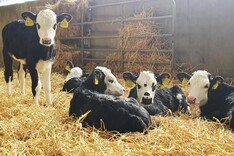The 2020-born stock on the Thrive programme demonstration farm were weighed last week and the results show that performance has been excellent over the winter period.
The heifers weighed 321kg on average, while the bullocks came in at 346kg.
This equates to an average daily gain of just over 1kg/day for the heifers and 1.1kg for the bullocks.
The diet has been good-quality silage (76 DMD and 14.5% crude protein) plus 2kg of a 16% protein ration.
Plan
The plan now is to get these stock out to grass in the coming weeks once conditions are favourable.
With this in mind, meal feeding has now ceased in order to ease the transition from the shed to a grass diet.
Last year, due to poor weather conditions, the yearling cattle weren’t turned out to grass until mid-March.
If we can bring forward the turnout date by a fortnight this year, it will really benefit the cattle and should help increase the percentage of cattle we can get slaughtered off grass in the back end of the year.
Difference from last year
The average weight of the group is now 11kg and 23kg heavier than at the same point last year for heifers and bullocks respectively.
So what are the contributing factors to achieving this?
Genetics
Based on the dairy beef index (DBI), the average beef value of the sires used for the 2020 crop of calves was greater than that of the 2019-born stock, meaning there is greater potential in the calves to go on and perform.
Grassland management
Grass measuring played a significant role during last year’s grazing season.
The calves were consistently hitting pre-grazing yields of around 1,200kg DM/ha.
This definitely helped liveweight gain at pasture.
Meal feeding
The decision was also made to continue feeding meal to the lightest batch of calves (46 of 140 calves) throughout the first season at grass.
This really closed the gap between the bottom third of calves and the average.
These combined measures have all helped the overall performance.
Now attention turns to planning for the grazing season and maximising liveweight gain from grazed grass.
The 2020-born stock on the Thrive programme demonstration farm were weighed last week and the results show that performance has been excellent over the winter period.
The heifers weighed 321kg on average, while the bullocks came in at 346kg.
This equates to an average daily gain of just over 1kg/day for the heifers and 1.1kg for the bullocks.
The diet has been good-quality silage (76 DMD and 14.5% crude protein) plus 2kg of a 16% protein ration.
Plan
The plan now is to get these stock out to grass in the coming weeks once conditions are favourable.
With this in mind, meal feeding has now ceased in order to ease the transition from the shed to a grass diet.
Last year, due to poor weather conditions, the yearling cattle weren’t turned out to grass until mid-March.
If we can bring forward the turnout date by a fortnight this year, it will really benefit the cattle and should help increase the percentage of cattle we can get slaughtered off grass in the back end of the year.
Difference from last year
The average weight of the group is now 11kg and 23kg heavier than at the same point last year for heifers and bullocks respectively.
So what are the contributing factors to achieving this?
Genetics
Based on the dairy beef index (DBI), the average beef value of the sires used for the 2020 crop of calves was greater than that of the 2019-born stock, meaning there is greater potential in the calves to go on and perform.
Grassland management
Grass measuring played a significant role during last year’s grazing season.
The calves were consistently hitting pre-grazing yields of around 1,200kg DM/ha.
This definitely helped liveweight gain at pasture.
Meal feeding
The decision was also made to continue feeding meal to the lightest batch of calves (46 of 140 calves) throughout the first season at grass.
This really closed the gap between the bottom third of calves and the average.
These combined measures have all helped the overall performance.
Now attention turns to planning for the grazing season and maximising liveweight gain from grazed grass.






 This is a subscriber-only article
This is a subscriber-only article










SHARING OPTIONS: